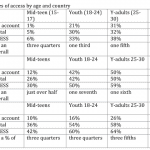Why ‘Chat Banking’ is the Future of Financial Services in Africa
I just returned from a trip to East Africa where I was working with a group to research user behavior as it relates to mobile money, mobile phone use and communication preferences. One of our biggest takeaways was that for many people, WhatsApp and SMS are important channels to chat with friends, conduct business and receive news updates. You don’t have to take my word for it though: Numerous reports indicate that messaging has overtaken social media in popularity, with the combined users of the top four chat apps outnumbering the combined users of the top four social networks. WhatsApp alone reports that users send 65 billion messages per day.
Yet despite the continued growth of messaging apps and changing user behavior, very little has been done to integrate financial services into the messaging experience. This is partly because WhatsApp has not provided a developer API – but that will likely change in the coming months (more on this below). I believe that there’s a vast opportunity for integrating financial services (eg: banking, payments, mobile money, etc.) into messaging apps, and that now is the time to invest in this integration.
What is ‘Chat Banking’?
Imagine you are chatting with your friend William on WhatsApp and planning a weekend trip together in Kenya. You wonder how much the trip would cost and whether you have enough in your current account to cover the expenses. Instead of going through a USSD menu or opening your bank’s app (if you even have that installed), you simply find your bank as another contact in WhatsApp and type “Balance” as a text message. The bank immediately texts you your current balance – which is enough to cover your share of the hotel reservations William is making. Next, you find your mobile money company on WhatsApp and text them “Pay Ksh 5000 to William.” Later that day, you get a WhatsApp message from the mobile network operator, asking if you want to top-up your account. It takes you a second to respond “Yes” – you’ve now covered both your travel arrangements and airtime for your trip, all through WhatsApp.
The key innovation in the preceding paragraph is not the technical integration necessary to connect these various providers, but rather the seamless user experience of never having to leave your favorite apps. When financial service providers put users at the center, they can offer these enabling services without requiring complex interactions or transactions.
Customers will love this approach for several reasons:
- It’s fast – it connects banking to the services they are already using.
- It’s easy – there is no learning curve, since the services plug into the messaging channels that everyone already knows how to use.
- It’s personalized – financial institutions can factor user preferences into the chat and create a personalized experience.
How Close is Chat Banking to Becoming Reality?
While the idea for chat banking (also referred to as “chatbots”) is still in its early stages, the technology to build this experience has already been in the market for years. A few banks in Africa have started to explore how they might integrate their services with messaging apps, including:
- ABSA Chat Banking (South Africa) – ABSA customers can use Facebook Messenger and Twitter to check their account balances, view their past transactions and make payments to approved contacts.
- Leo by United Bank Africa (Nigeria) – United Bank Africa has unveiled an interactive chat banker that enables customers to make use of their social media accounts to carry out transactions. Leo has had over 35 million conversations and processed over 500,000 transactions.
- MoMo by Orange Money (Madagascar) – Orange Money Madagascar was the first mobile money company to build and launch a chatbot to help onboard users, answer basic customer service questions, and provide helpful tips about the service. (Disclaimer: this is a project that my startup worked on.)
How Should a Financial Institution Get Started?
Any organization thinking about launching a chatbot must answer several questions, such as:
- Do we want to treat messaging as another channel or a new experience?
- What channels do we want to support?
- How does this change our customer service experience?
- What kind of budget do we have to support this project?
I have spoken to numerous banks and mobile money companies about their technology strategies. Many of them are interested in working on a small proof-of-concept (POC) or a limited pilot. A POC or pilot would allow them to see how the technology works, get feedback from internal and external stakeholders, and also get buy-in from decision makers. And working with a fintech partner would allow a bank to do this without investing too many resources up front.
Many of our potential clients are also interested in exploring this space to prepare their businesses for the eventual launch of a WhatsApp developer API. Preparing their back-end chatbot infrastructure now could help them avoid spending 6-12 months catching up to competitors once WhatsApp allows integration. It’s clear from my conversations with players in this space that these developments are coming: It’s only a matter of time.
Sidharth Garg is the founder and CEO of Teller. He also worked at Facebook, where he helped launch payment products like P2P Payments and Facebook Gifts.
- Categories
- Finance, Technology
- Tags
- digital finance, fintech



